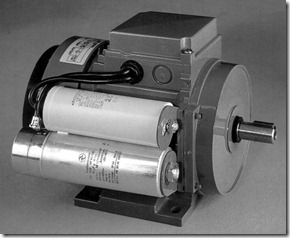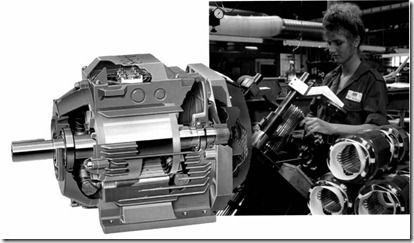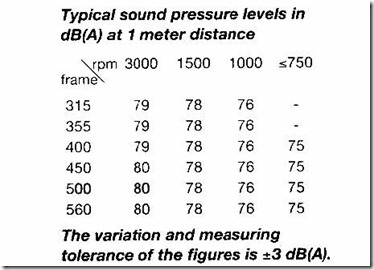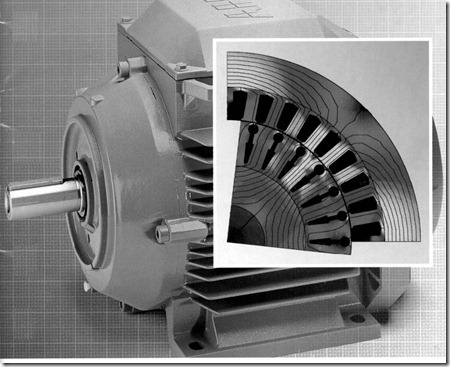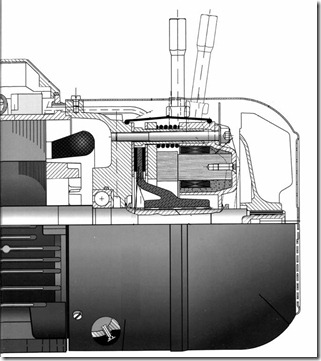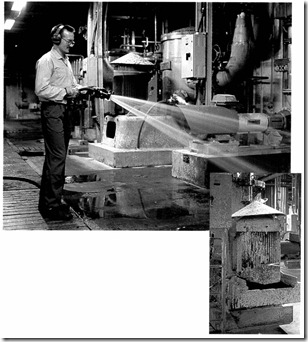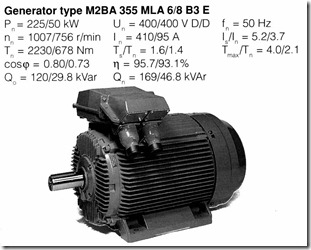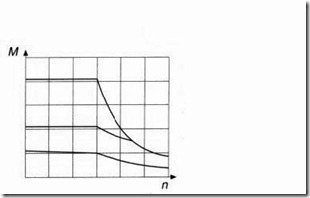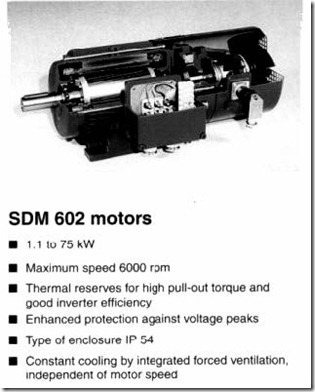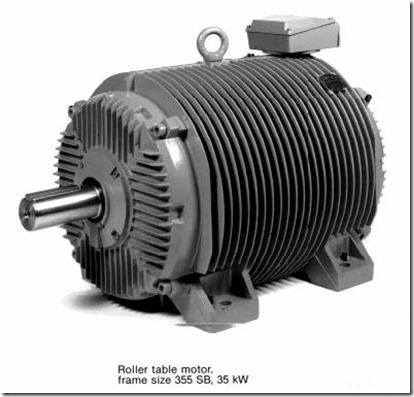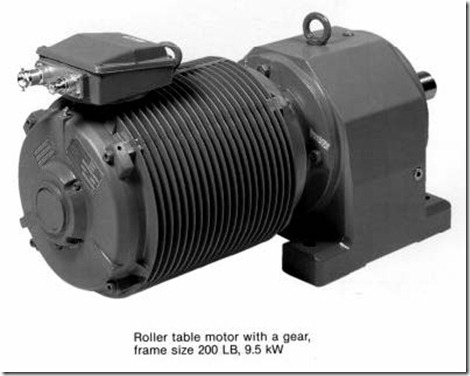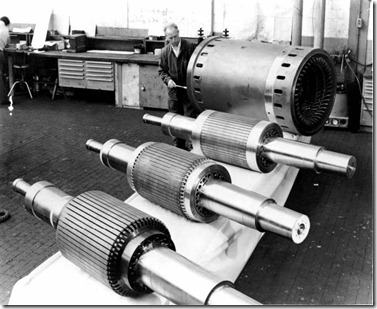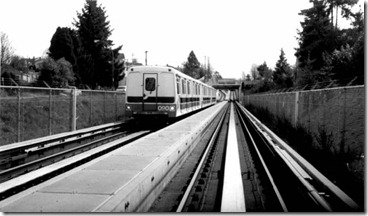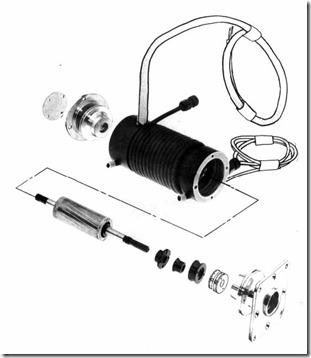Induction motors are, in general, supplied from single-phase or three-phase a.c. power grids.
Figure 1.4 Start-run capacitor single phase induction motor (Source ABB)
Single-phase supply motors, which have two phase stator windings to provide selfstarting, are used mainly for home applications (fans, washing machines, etc.): 2.2 to 3 kW. A typical contemporary single-phase induction motor with dual (start and run) capacitor in the auxiliary phase is shown in Figure 1.4.
Three-phase induction motors are sometimes built with aluminum frames for general purpose applications below 55 kW (Figure 1.5).
Figure 1.5 Aluminum frame induction motor (Source: ABB) Table
Besides standard motors (class B in the U.S.A. and EFF1 in EU), high efficiency classes (class E in U.S.A. and EFF2 and EFF3 in EU) have been developed. Table 1.2. shows data on EU efficiency classes EFF1, EFF2 and EFF3.
Even, 1 to 2% increase in efficiency produces notable energy savings, especially as the motor ratings go up.
Cast iron finned frame efficient motors up to 2000 kW are built today with axial exterior air cooling. The stator and rotor have laminated single stacks. Typical values of efficiency and sound pressure for such motors built for voltages of 3800 to 11,500 V and 50 to 60 Hz are shown on Table 1.3 (source:ABB). For large starting torque, dual cage rotor induction motors are built (Figure 1.6).
Table 1.3.
Figure 1.6 Dual cage rotor induction motors for large starting torque (source: ABB)
There are applications (such as overhead cranes) where for safety reasons, the induction motor should be braked quickly, when the motor is turned off. Such an induction motor with integrated brake is shown on Figure 1.7.
Figure 1.7 Induction motor with integrated electromagnetic brake (source: ABB)
Figure 1.8 Induction motor in pulp and paper industries (source: ABB)
Induction motors used in the pulp and paper industry need to be kept clean from excess pulp fibres. Rated to IP55 protection class, such induction motors prevent the influence of ingress, dust, dirt, and damp (Figure 1.8).
Aluminum frames offer special corrosion protection. Bearing grease relief allows for greasing the motor while it is running.
Induction machines are extensively used for wind turbines up to 750 kW per unit and more. A typical dual winding (speed) induction generator with cage rotor is shown in Figure 1.9.
Figure 1.9 Dual stator winding induction generator for wind turbines (source: ABB)
Wind power to electricity conversion has shown a steady growth since 1985. [2] The EU is planning to have 8000 MW of wind power plants by the year 2008. Today, about 3000 MW of wind power generators are at work worldwide, a good part in California.
The environmentally clean solutions to energy conversion are likely to grow in the near future. A 10% coverage of electrical energy needs in many countries of the world seems within reach in the next 20 years. Also small power hydropower plants with induction generators may produce twice as that amount. Induction motors are used more and more for variable speed applications in association with PWM converters.
Up to 2500 kW at 690 V (line voltage, RMS) PWM voltage source IGBT converters are used to produce variable speed drives with induction motors. A typical frequency converter with a special induction motor series are shown on Figure 1.10.
Constant cooling by integrated forced ventilation independent of motor speed provides high continuous torque capability at low speed in servodrive applications (machine tools, etc.).
Figure 1.10 Frequency converter with induction motor for variable speed applications (source: ABB)
Figure 1.11 Roller table induction motors without a.) and with b.) a gear (source: ABB)
Roller tables use several low speed, (2p1 = 6-12 poles) induction motors with or without mechanical gears, supplied from one or more frequency converters for variable speeds.
The high torque load and high ambient temperature, humidity and dust may cause damage to induction motors unless they are properly designed and built.
Totally enclosed induction motors are fit for such demanding applications (Figure 1.11). Mining applications (hoists, trains, conveyors, etc.) are somewhat similar.
Induction motors are extensively used in marine environments for pumps, fans, compressors, etc. for power up to 700 kW or more. Due to the aggressive environment, they are totally enclosed and may have aluminum (at low power), steel, or cast iron frames (Figure 1.12).
Figure 1.12 Induction motor driving a pump aboard a ship (source: ABB)
Aboard ship, energy consumption reduction is essential, especially moneywise, as electric energy is produced through a diesel engine electrical generator system.
Suppose that electric motors aboard a ship amount to 2000 kW running 8000 hours/year. With energy cost of U.S.$ 0.15/kWh, the energy bill difference per year between two induction motor supplies with 2% difference in motor efficiency is 0.02 × 2000 × 8000h × 0.15 = U.S.$ 55,200 per year.
Electric trains, light rail people movers in or around town, or trolleybuses of the last generation are propulsed by variable speed induction motor drives.
Most pumps, fans, conveyors, or compressors in various industries are driven by constant or variable speed induction motor drives.
Figure 1.13 2500 kW, 3 kV, 24,000 rpm induction motor (source: ABB)
Figure 1.14 The BC transit system in Vancouver: with linear motion induction motor propulsion
(source: UTDC)
The rotor of a 2500 kW, 3 kV, 400 Hz, 2 pole (24,000 rpm) induction motor in different stages of production as shown on Figure 1.13, proves the suitability of induction motors to high speed and high power applications.
Figure 1.15 shows a 3.68 kW (5 HP), 3200 Hz (62,000 rpm) induction motor, with direct water stator cooling, which weighs only 2.268 Kg (5 Pds). This is to
show that it is the rather torque than the power that determines the electric motor size.
In parallel with the development of rotary induction motor, power electronics drives linear motion induction motors have witnessed intense studies with quite a few applications. [9, 10] Among them Figure 1.14 shows the UTDC-built linear induction motor people mover (BC transit) in Vancouver now in use for more than a decade.
The panoramic view of induction motor applications sketched above is only to demonstrate the extraordinary breadth of induction machine speed and power ratings and of its applications both for constant and variable speeds.
Figure 1.15 3.68 kW (5 HP), 3200 Hz (62,000 rpm) induction motor with forced liquid cooling
1.4. CONCLUSION
After 1885, more than one century from its invention, the induction motor steps into the 21st century with a vigour unparalleled by any other motor.
Power electronics, digital control, computer-added design, and new and better materials have earned the induction motor the new sobriquet of “the racehorse of industry” in addition to the earlier one of “the workhorse of industry”.
Present in all industries and in home appliances in constant and variable speed applications, the induction motor seems now ready to make the electric starter/generator system aboard the hybrid vehicles of the near future.
The new challenges in modeling, and optimization design in the era of finite element methods, its control as a motor and generator for even better
performance when supplied from PWM converters, and its enormous application potential hopefully justifies this rather comprehensive book on induction machines at the dawn of 21st century.
1.5. REFERENCES
1. R.J. Kerkman, G.L. Skibinski, D.W. Schlegel, AC drives; Year 2000 and Beyond, Record of IEEE-APEC ’99, March, 1999.
2. P. Gipe, Wind Energy Comes of Age, Wiley & Sons Inc., New York, 1995.
3. H. Sequenz, The Windings of Electric Machines, vol.3.: A.C. Machines, Springer Verlag, Vienna, 1950 (in German).
4. R. Richter, Electric Machines-Vol. 4-induction machines, Verlag Birkhauser, Bassel/Stuttgart, 1954 (in German).
5. P. Alger, The Nature of Induction Machines, 2nd edition, Gordon & Breach, New York, 1970.
6. C. Veinott, Theory and Design of Small Induction Motors”, McGraw-Hill, New York, 1959.
7. J. Stepina, Single Phase Induction Motors, Springer Verlag, 1981 (in German).
8. B. Heller and V. Hamata, Harmonic Field Effects in Induction Machines, Elsevier Scientific, Amsterdam, 1977.
9. E. Laithwaite, Induction machines for special purposes, Newness, 1966.
10. Boldea & S.A. Nasar, Linear Motion Electromagnetic Systems, Wiley Interscience, 1985.
11. EURODEEM by European Commission on Internet:
http://iamest.jrc.it/projects/eem/eurodeem.htm
